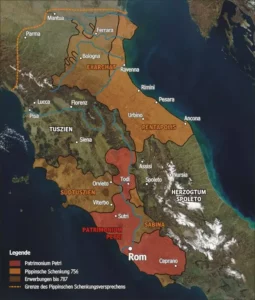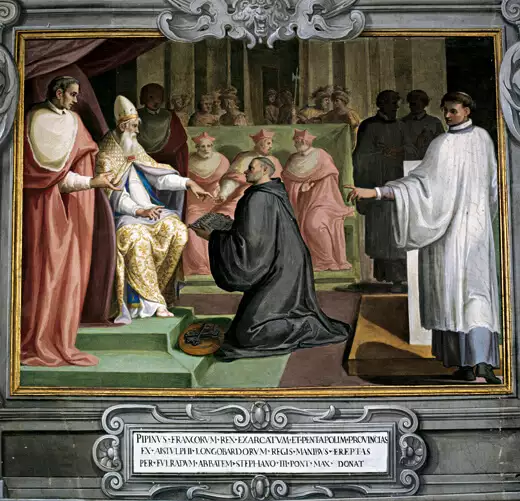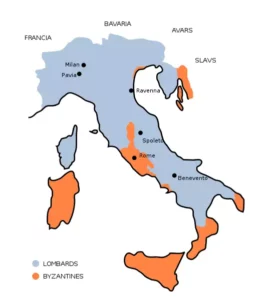Donation of Pepin

The Donation of Pepin or Promissio Carisiaca (also known as Donatio Carisiaca, Treaty of Quierzy, pact of Quierzy or donation of Quierzy) was an act signed by the king of the Franks Pepin the Short in 754. The document contains the promise of donation to the Apostolic See of a series of territories formerly belonging to the Byzantine Empire and subtracted from it by the Lombards. The adjective carisiac derives from the Latin name of Quierzy (Carisium). The act marks the beginning of the protection of the Franks on the Apostolic See.
Background
In 751 the Lombards conquered Ravenna. The Exarchate of Italy passed under Germanic rule, which also included the Duchy of Rome. The Lombard king Astolfo did not attack Rome directly, but continued to stay in his capital, Pavia.
Two years later the Byzantine emperor Constantine V decided to ask Astolfo to return the stolen territories. Since the last exarch Eutychius had fallen in battle, the only personality capable of carrying out the mission was the Roman pontiff. He sat on the throne of Peter Pope Stephen II (752-757). The pontiff was joined in Rome by a high dignitary ( silentiarius ) of the imperial court, Giovanni, who had left on purpose from Constantinople. In October 753 the two left Rome and went from Astolfo to Pavia. The emperor had officially instructed the pope to negotiate with the Lombard king the restitution of the occupied cities. John, on his part, delivered to Astolfo one or more letters from Constantine V. The mission was not successful. His task done,Giovanni returned to Rome.
Journey of Stephen II to the Franks

Stephen II, on the other hand, continued his journey and went to France, to the court of King Pepin the Short. He joined him on January 6, 754 in Ponthion (90 km south of Reims), where Pippin had one of his residences. The pope explained to the Frankish king that, with the disappearance of the Byzantine presence in Italy, the city of Rome would be in grave danger. It was therefore for the benefit of St. Peter the Apostle that the king of the Franks would have to intervene. It was therefore not a question of defending a city, albeit an important city like Rome, but the Sancta Dei ecclesia reipublicæ Romanorum , that is the "common good" constituted by the holy Church of God. With this new formula the pontiff intended to circumvent the lack of a mandate directed by the emperor to deal with the king of the Franks .
In fact, the agreement consisted not in returning the recovered lands to the emperor, but in donating them to St. Peter himself. Pippin would have ceded the territories to St. Peter the Apostle and, for him, to the reigning pontiff and his successors in perpetuity . The promised donation had as its object Ravenna and all the other cities of the Exarchate and the Pentapolis that King Astolfo had taken since his accession to the throne in July 749. The deed also represented a guarantee, for the purpose of safeguarding the former duchy of Rome, offered by the Franks .
Pippin summoned the nobles of France. A few months later, on April 14, in the royal villa of Carisium (Quierzy, 90 km north of Reims), the assembly of the nobles ratified the Promissio . The terms of the agreement were as follows :
- Pippin undertook to stop the Lombards with arms and to force their king to return the lands that had already belonged to the Exarchate of Ravenna (including the Pentapolis) and to the Roman Duchy;
- Pope Stephen II in exchange solemnly consecrated the Carolingian dynasty, effectively erasing the shame of the usurpation of the throne against the legitimate Merovingian dynasty, and also granted Pippin the prestigious title of Patricius Romanorum (protector of Rome and Christianity, up to then reserved for the Byzantine exarch). This actually took place on July 28, 754: that day, in the monastery of Saint Denis, Pope Stephen conferred the royal anointing on Pippin and his two sons, repeating and confirming with the papal authority the consecration that had been given three years earlier to Pippin by Archbishop Bonifacio.
Implementation of the agreement

Pippin fails to implement the promise
The prerequisite for the implementation of the promissio was the destruction of the Lombard kingdom by manu military . Subsequently the king of the Franks would have implemented the Promissio . According to the pacts, the Franks would have annexed the Langobardia Maior, while the former Byzantine territories of Italy would have gone to the Holy See. The border line between the two domains started from the coast of the Tyrrhenian Sea at Luni and reached Monselice, on the border with the Byzantine territory of Venetikà (Venice).
In 755 Pipino defeated Astolfo at the locks (border fortifications) of the Val di Susa. The Lombard king promised the restitution of Ravenna cum diversis civitatibus (First Peace of Pavia, June 755), but did not keep the pacts. In the spring of 756 Pippin went back to Italy but, contrary to his plans, he was unable to annihilate the Lombard kingdom. A peace was signed in Pavia (Second Peace of Pavia, June 756). Astolfo capitulated and had to accept harsh conditions: the delivery of a third of the treasure of the Lombard crown, the payment of an annual tribute to Pipino and the cession of the city of Ravenna and the other previously conquered cities. The Lombard kingdom, however, retained its independence for another twenty years. The frank victory, therefore, did not allow Pippin to fully implement the promissio . Pippin never returned to Italy and died in 768 without ever having set foot in Rome .
Charlemagne carries out the promissio
On 5 June 774 Charlemagne, son and successor of Pipino, took Pavia, sanctioning the end of the Lombard reign. Since his predecessor's promise had not been made enforceable, he went to Rome where he had a second pledge of donation drawn up, confirming the previous one.
The biographer of Pope Adrian I (772-795) compiled a summary of the document. It contains a list of the territories that would have belonged to the Diocese of Rome after the definitive defeat of the Lombards. According to the agreements made by Pope Stephen II and King Pepin, the delimitation of the respective domains was constituted by the director Luni - Monselice. Therefore , all the cities of the Cispadan plain from Parma to Rimini with the addition of Mantua belonged to the Patrimonium Sancti Petri . To the south, the border line was represented by the central and southern Apennine ridge, including the duchies of Spoleto and Benevento.
The donation was perfected by Charlemagne according to a typical Roman-Germanic procedure: on 6 April 774 the participants gathered in front of the tomb of Peter the apostle. Here the act was read; after the reading, the Frankish king placed the document on the tomb and placed the keys of the city on it ( claves portarum civitatum ). The gesture meant the transfer of ownership of the aforementioned territories to the See of San Pietro had taken place . On the following 7 July the king of the Franks entered Pavia and on 16 July he adorned himself with the triple title of Rex Francorum et Langobardorum atque Patricius Romanorum .
Conclusion
The territories whose restitution the Holy See was asking belonged to three different types :
- Territories taken from the Byzantines by King Astolfo (who came to power in 749);
- Territories that were Byzantine in 680, when a peace was concluded between the Lombards and the empire;
- Territories conquered by the Lombards in the first years after the invasion of Italy.
The whole was very heterogeneous, extending from Corsica to Istria, from Mantua to the Duchy of Tuscia.
Pope Adrian I, with a great sense of reality, made requests only on territories bordering Lazio. Thus it was that he obtained a part of the Sabina from Charlemagne (781); a series of cities from Soana to Populonia to the north and, to the south, Sora, Arpino, Arce and Aquino (787).
The set of territories to which the Apostolic See aspired with Stephen II was very similar to suburbicarian Italy of Roman memory. What he actually obtained, on the other hand, seemed to trace the judicial district of Praefectus Urbis , which extended over Lazio for one hundred Roman miles both north and south of the city, that is, from Talamone, near Monte Argentario, up to Minturno, on the Liri river.
Contenido relacionado
GM-NAA I/O
Kingdom of Iberia
Declaration of Independence of the United States of America